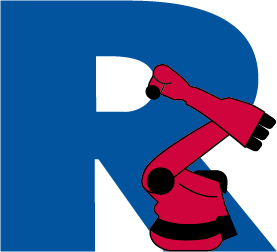


RF::RobSim is the flexible robot compiler of
. This allows new robot programs to be simulated and tested even before actual commissioning. Existing robot programs
can also be loaded and executed.
It is possible to load kinematics models and programs of all known manufacturers of industrial robots or to create new kinematics. The most frequently used robot kinematics are already stored in RF::RobSim. The integrated syntax check of RF::RobSim makes it easy to correct syntax errors. All the robot part points are calculated exactly and hence reachability of all the part points in the program is ensured.
Through the interfaces of WinMod and ShM RF::RobSim can communicate externally with various programs. This enables the virtual robots to interact with real or virtual plant controllers (PLC) and the signal play between the systems can be optimized. RF::RobSim is the perfect tool for virtual commissioning of robot programs.
A variety of tools are available during program processing to facilitate debugging of the robot programs. The intuitive user interface of RF::RobSim allows the program to be operated by any user.